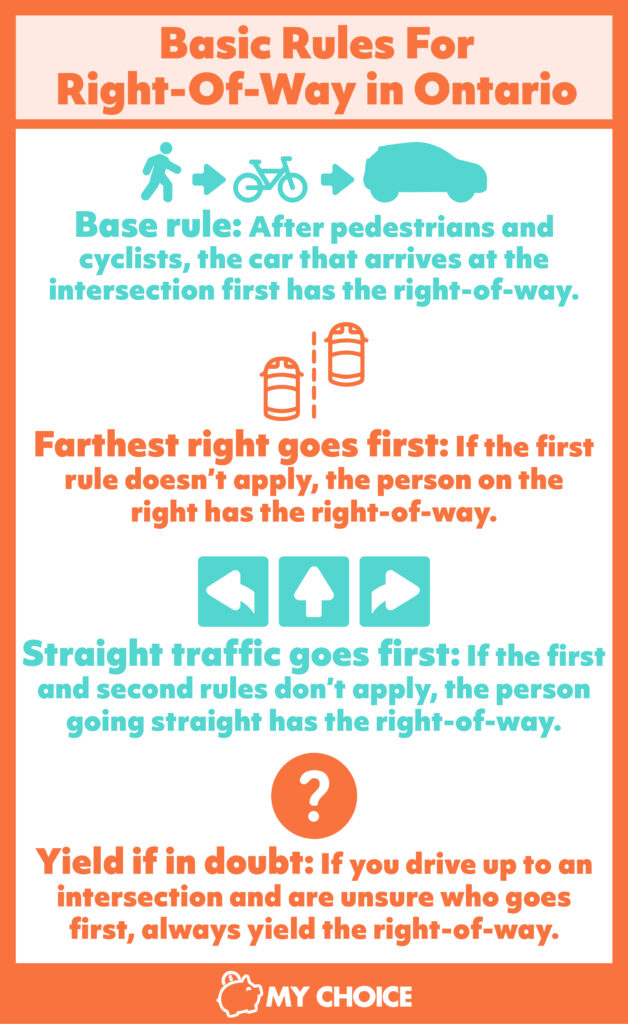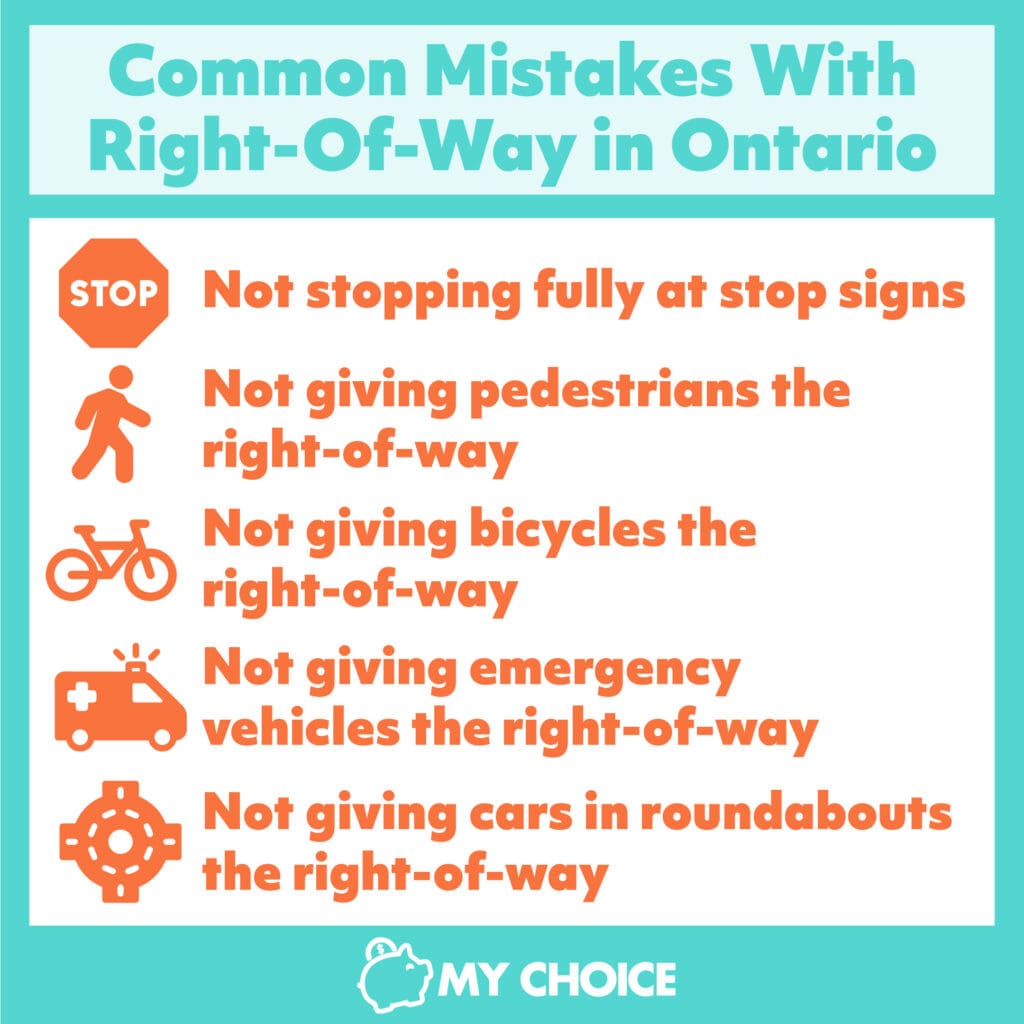
Right-of-way rules are important to follow as they ensure traffic flows smoothly and reduce the risk of accidents. But, while important, they can also be confusing to some – thankfully, we’re here to help!
Read on to learn everything about right-of-way road rules in Ontario, how they benefit drivers, and some common right-of-way mistakes.
What Does Right-Of-Way Mean?
Right-of-way is the legal right pedestrians or vehicles have to go first in specific traffic situations, such as when approaching an intersection or turning into oncoming traffic.
If you have the right-of-way in a traffic situation, you have the legal right to go first. If you don’t have the right-of-way, you need to let other drivers, cyclists, and pedestrians go first – this is called yielding the right-of-way.
Generally, right-of-way rules give precedence to pedestrians and oncoming traffic, but there are exceptions to that rule, such as when there’s an emergency vehicle passing.
Right-Of-Way Rules in Ontario
Right-of-way rules can be confusing, and failing to follow them could result in a fine or even a car accident.
Let’s look at the basic rules for right-of-way in Ontario:
- Base rule: After pedestrians and cyclists, the car that arrives at the intersection first has the right-of-way.
- Farthest right goes first: If the first rule doesn’t apply – for example, when drivers arrive at the same time – the person on the right has the right-of-way.
- Straight traffic goes first: If the first and second rules don’t apply, the person going straight has the right-of-way.
- Yield if in doubt: If you drive up to an intersection and are unsure who goes first, always yield the right-of-way.

Now, let’s go over the right-of-way road rules in Ontario for specific traffic situations.
Two-Way Stop Sign Intersection
If you drive up to a two-way stop, you need to yield to through and oncoming traffic. If you’re turning left, oncoming traffic has the right-of-way. However, if you arrive at the same time as another car, the driver on the right goes first.
Example
Let’s say you stop at a two-way stop and want to turn left, but you notice that there’s a car already waiting opposite you that wants to go straight. In this situation, you need to yield and let that car pass before making your left turn.
If you’re both going straight, neither car crosses the other’s path, so both may continue straight ahead when the road is clear.
Three-Way Stop Sign Intersection
If you’re driving on a through road (the road with no stop signs), then you have the right-of-way. Just make sure that the road is clear of pedestrians, cyclists, and other cars before driving on.
Example
Imagine that you drive up to a three-way stop and want to turn left onto the through road. However, there’s a driver to your left that’s continuing straight, and a driver waiting on your right that wants to turn left. What do you do?
In this situation, the car driving straight has the right-of-way, then the car to your right, and then you.
Four-Way Stop Sign Intersection
At a four-way stop, the vehicle that arrived first can drive first. If everyone arrives at the same time, yield to the driver on your right. If you’re unsure who came first, it’s best to wait and yield to other drivers.
Example
Let’s say four drivers all stop at a four-way intersection at the same time – the cars that are driving straight have the right-of-way. But, if you came first, you have the right-of-way, even if you’re turning.
Intersections With No Lights or Stop Signs
The same rules apply at intersections with no lights or stop signs as at a four-way stop. After pedestrians and cyclists cross, the car that arrives first has the right-of-way. If everyone arrives at the same time, remember to yield to the cars on your right and the cars going straight.
Turning Into Oncoming Traffic
Drivers turning left or right into oncoming traffic must always yield the right-of-way to the following:
- Pedestrians
- Cyclists
- Other cars
Exiting Your Driveway
The rules for turning into oncoming traffic apply here, so the road has to be completely clear before you fully exit your driveway.
Entering a Roundabout
Right-of-way rules for roundabouts are the same rules for turning into oncoming traffic. First, yield to pedestrians and cyclists, and, then, yield to any cars already in the roundabout. After the road is clear, you can safely drive into the roundabout and now have the right of way.
Merging Into Highway Traffic
When you’re driving up to a highway, you need to give way to cars already on the highway. Match your speed with theirs, keep an eye out for an opening, then merge into highway traffic when it’s safe.
At a Pedestrian or School Crossing
Pedestrians always have the right-of-way when waiting at a pedestrian or school crossing, so drivers must come to a complete stop and let pedestrians cross before continuing.
In a Parking Lot
Drivers need to yield to pedestrians and cars already in the traffic lane. Parking lot accidents happen often in Canada, so drive slowly and scan for other cars backing out of their parking space.
When Must I Yield the Right-Of-Way?
You must yield the right of way in these situations:
- When pedestrians are waiting at a crossing
- When an emergency vehicle is passing
- When turning left (yield to pedestrians and oncoming traffic)
- When there’s oncoming traffic
- When a car is in an intersection
Who Has Right-Of-Way at Construction Sites?
In a construction zone, the cars on the road have the right-of-way, but there will be construction signs and possibly personnel directing traffic. Always make sure to drive slowly and pay attention to any instructions they give you.
What Do I Do if There’s No Power at an Intersection?
When there’s no power at an intersection, you should treat it as a four-way stop. That means the car that arrives first drives first. If you and another car arrive at the same time, always yield to the car on your right.
What Do I Do When Sharing the Road With Horses?
Horses and carriages have the same right-of-way rules as pedestrians. So, you must always yield when a horse rider is crossing the road. If the horse rider is on the road but continuing straight, you can pass. Just keep in mind that horses are easily startled by loud noises and sudden movements, so slow down and drive carefully.
Benefits of Right-Of-Way Rules
Right-of-way rules can be tricky to master. But they’re important for everyone’s safety, and they have many benefits. Those benefits are:
- Safer pedestrians
- Reduced traffic jams, accidents, and road rage
- Lower likelihood of conviction in an accident (because you followed the rules)
- Easier to drive defensively (you can anticipate what other drivers will do)
Common Mistakes With Right-Of-Way in Ontario
- Not stopping fully at stop signs
- Not giving pedestrians the right-of-way
- Not giving emergency vehicles the right-of-way
- Not giving bicycles the right-of-way
- Not giving cars in roundabouts the right-of-way

Penalty for Not Following Right-Of-Way Rules in Ontario
If you fail to follow right-of-way rules in Ontario, there are some penalties involved:
- You’ll get a fine of $110.
- You’ll get three demerit points on your license.
- It’ll stay on your insurance record for three years.
- Your insurance rates will likely increase.
How Breaking the Right-Of-Way Rules Affects Your Insurance Rates in Ontario
How your insurance rates are affected depends on your insurance provider. Some companies will only look for past driving accidents, but others will be more thorough and examine your entire driving record.
The thing that impacts your rates the most is demerit points on your license. Demerits significantly affect the rates of your car insurance in Ontario – in the worst case, they could even result in the insurer refusing to insure you.
Final Thoughts
Knowing who has the right-of-way in which situation can be confusing at times, but learning the rules and sticking to them keep you and everyone else safe while on the road. Drive safe!








